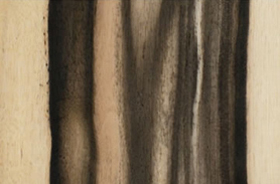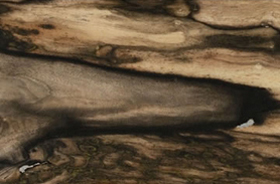Sewable wood

lets us treat wood like fabric
“Sewable wood” is a new material made by treating sliced wood 0.12–0.15 mm thick in a special way.
It is characterized by being flexible like fabric, yet still having the texture and fragrance of wood, and it can be processed in a sewing machine.

“Sewable wood” is a product that has overturned the fixed concepts of wood.
For more than 70 years, ever since our founding, we have continued to make woodcraft products. Until recently, we made our products based on the concept that wood = hard. However, getting caught up in a single image meant that we couldn’t create new products according to our customers’ wishes. So we thought flexibly, and decided to take a second look at the possibilities of wood.
It was the thin, shaved wood that we use for umbrellas for lighting equipment that inspired us to develop sewable wood. We felt that there were new possibilities in this wood, which was sliced so thinly that light could shine through it.
We developed our sewable wood over ten years through repeated trial and error—it’s wood, but it’s so flexible that it can be folded, and despite this it is also strong. In addition, it has the durability to withstand dozens of washes. Above all else, it has the unique fragrance of wood and the beauty of its grain. This new material, which surprised everyone, has opened the door to new expressions created with wood.
Always keep the warmth of wood close
“Sewable wood” has expanded the possibilities of wood, and has been applied to a variety of products ever since it was created. This material, which offers the comfort of nature, has become a multifaceted item used for fashion, other goods, interiors, and more, and is coloring our world.

We offer seven sheets of six types of wood, all grown in Japan: black persimmon, figured ash, figured Japanese horse chestnut, cherry, Japanese cypress, and Japanese cedar
Sheet size: 90 × 180 cm/30 × 90 cm
*Please be aware that as these are natural woods, the grain of each will differ.


Black persimmon
One in 10,000 persimmon trees live for hundreds of years and fulfil several criteria. These trees grow to have beautiful black and white patterns, and are known as black persimmons. They have been treated with great care as valuable treasures from ancient times—a number of the treasures in the Shosoin Repository, a famous treasure house in Nara, are made from black persimmon.

Figured ash
Ash has clear tree rings; the boundary between the sapwood and the heartwood is clear, with pale yellow-white sapwood and dark brown heartwood. This sometimes creates beautiful grains. Burl ash has circular swirls, and the complex patterns give a sense of the wonder of nature’s tapestry; this grain is one that collectors covet.

Figured Japanese horse chestnut
This wood has fine bark. It displays colors from a pale red-yellow to a tan brown, and its surface has a luster like silk. Figured Japanese horse chestnut, with ripple marks, is especially prized, with a high rarity value. It may be wood, but it has a beautiful brilliance and silk-like suppleness.

Cherry
Cherry has a straight grain and narrow tree rings. Its wood is fine and solid, and its age is somewhat unclear. It is moderately hard, and is a good timber to use as a material because it doesn’t warp much. It has a wide range of uses, including as a material for high-level construction, for furniture, for utensils, and for musical instruments. Cherry is especially familiar to Japanese people, to whom it is a beloved tree.

Japanese cypress
The sapwood of this tree is a pale yellow-white, while the heartwood ranges from yellow-white to dusky pink. The difference between the sapwood and the heartwood isn’t very clear. This wood has a characteristic fragrance, which is liked by many different people. It has a wide array of uses: in addition to its role as a material for high-level construction, including shrines and temples, it is used for joinery, fittings, and furniture.

Japanese cedar
The boundary between this tree’s sapwood and heartwood is clear: the sapwood is white, and the heartwood ranges from a dusky pink color to a reddish brown, occasionally tending towards blackish brown. It has a clear, straight grain. Japanse cedar wood is straight and light, and is not prone to warping. This wood also has a stunning grain and a characteristic fragrance—it is an excellent wood that is widely loved.
